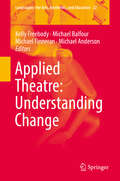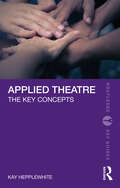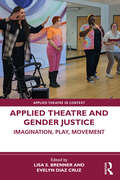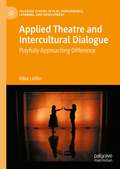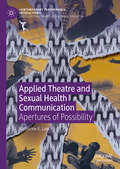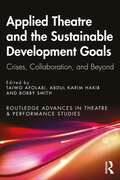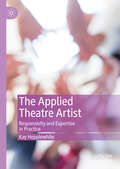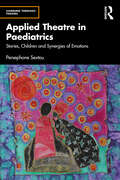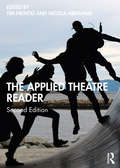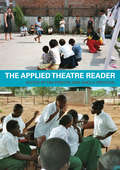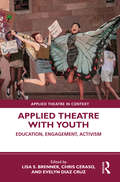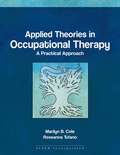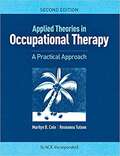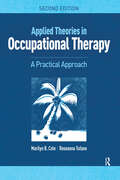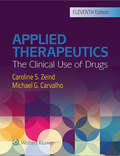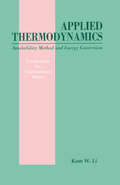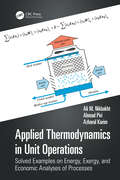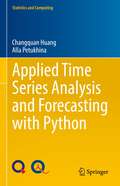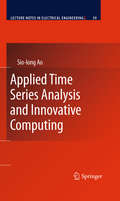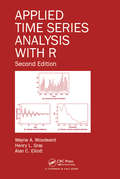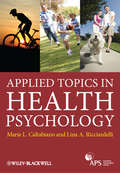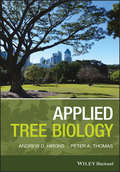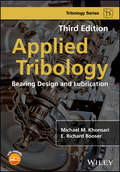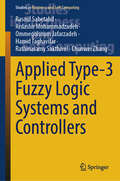- Table View
- List View
Applied Theatre: Understanding Change (Landscapes: the Arts, Aesthetics, and Education #22)
by Kelly Freebody Michael Balfour Michael Finneran Michael AndersonThis volume offers researchers and practitioners new perspectives on applied theatre work, exploring the relationship between applied theatre and its intent, success and value. Applied theatre is a well-established field focused on the social application of the arts in a range of contexts including schools, prisons, residential aged care and community settings. The increased uptake of applied theatre in these contexts requires increased analysis and understanding of indications of success and value. This volume provides critical commentary and questions regarding issues associated with developing, delivering and evaluating applied theatre programs. Part 1 of the volume presents a discussion of the ways the concept of change is presented to and by funding bodies, practitioners, participants, researchers and policy makers to discover and analyse the relationships between applied theatre practice, transformative intent, and evaluation. Part 2 of the volume offers perspectives from key authors in the field which extend and contextualize the discussion by examining key themes and practice-based examples.
Applied Theatre: The Key Concepts (Routledge Key Guides)
by Kay HepplewhiteThis accessible book outlines the key ideas that define the global phenomenon of applied theatre, not only its theoretical underpinning, its origins and practice, but also providing eight real-life examples drawn from a diversity of forms and settings.The clearly arranged topic sections entitled When, What, Who, Why and Where emphasise the responsive nature of applied theatre, its social context and the importance of a beneficial outcome for participants, which can connect fields as disparate as health, criminal justice, education and migration. Labels and terms are explained, along with applied theatre’s core values, motivations and objectives, allowing the reader to build a coherent understanding of its distinguishing features.Applied Theatre: The Key Concepts is aimed at students, academics, artists and practitioners of applied theatre as well as those with an interest in this vital blend of social and creative practice.
Applied Theatre and Gender Justice: Imagination, Play, Movement (Applied Theatre in Context)
by Lisa S. Brenner Evelyn Diaz CruzApplied Theatre and Gender Justice is a collection of essays highlighting the value and efficacy of using applied theatre to address gender in a broad range of settings, identifying challenges, and offering concrete best practices.This book amplifies and shares lessons from practitioners and scholars who use performance to create models of collective solidarity, building upon communities’ strengths toward advocating for justice and equity. The book is divided into thematic sections, comprising three essays addressing a range of questions about the challenges, learning opportunities, and benefits of applied theatre practices. Further exploring the themes, issues, and ideas, each section ends with a moderated roundtable discussion between the essays' authors.Part of the series Applied Theatre in Context, Applied Theatre and Gender Justice, this book is an accessible and valuable resource for theatre practitioners and the growing number of theatre companies with education and community engagement programs. Additionally, it provides essential reading for teachers and students in a myriad of fields: education, theatre, civic engagement, criminal justice, sociology, women and gender studies, environmental studies, disability studies, and ethnicity and race studies.
Applied Theatre and Intercultural Dialogue: Playfully Approaching Difference (Palgrave Studies In Play, Performance, Learning, and Development)
by Elliot LefflerThis book examines applied theatre projects that bring together diverse groups and foster intercultural dialogue. Based on five case studies and informed by play theory, it argues that the playful elements of theatre processes nurture a unique intimacy among diverse people. However, this playful quality can also dampen explicit conversations about participants’ cultural differences, and defer an interrogation of people’s own entrenchment in systemic power imbalances. As a result, addressing these differences and imbalances in applied theatre contexts may require particular strategies.
Applied Theatre and Sexual Health Communication: Apertures of Possibility (Contemporary Performance InterActions)
by Katharine E. LowThis book analyses the partnership between applied theatre and sexual health communication in a theatre-making project in Nyanga, a township in South Africa. By examining the bridges and schisms between the two fields as they come together in the project, an alternative way of approaching sexual health communication is advocated. This alternative considers what it is that applied theatre does, and could become, in this context. Moments of value which lie around the margins of the practice emerge as opportunities that can be overlooked. These somewhat ephemeral, intangible moments, which appear on the edges, are described as ‘apertures of possibility’ and occur when one takes a step back and realises something unnoticed in the moment. This book offers an invitation to pause and notice the seemingly insignificant moments that often occurs tangentially to the practice. The book also calls for more outcry about sexual health and sexual violence, arguing for theatre-making as a route to multitudes of voices, nuanced understandings, and diverse spaces in which discussions of sexuality and sexual health are shared, felt, and experienced.
Applied Theatre and the Sustainable Development Goals: Crises, Collaboration, and Beyond (ISSN)
by Bobby Smith Taiwo Afolabi Abdul Karim HakibThis book is the first definitive publication to consider the intersections of applied theatre and the Sustainable Development Goals (SDGs) – a series of goals which have shaped development and social justice initiatives from 2015 to 2030.It brings together emerging and leading scholars and practitioners engaged in creative and community contexts globally. In so doing, the book offers critical insights to explore the convergences, complexities, and tensions of working within development frameworks, through theatre. Divided into three thematic areas, it maps out the ways in which applied theatre has related to the SDGs, examines issues with global collaborations, and, as 2030 approaches and the SDG era draws to a close, interrogates such practices, envisioning what the role of applied theatre might be in the post-SDG era. The book provokes reflection about this specific era of applied theatre and global development, as well as discussion regarding what comes next.This volume will be of importance to students, artists, scholars, practitioners, and policymakers working in applied theatre and the field of development.
The Applied Theatre Artist: Responsivity and Expertise in Practice
by Kay HepplewhiteThis book analyses the work of applied theatre practitioners using a new framework of ‘responsivity’ to make visible their unique expertise. In-depth investigation of practice combines with theorisation to provide a fresh view of the work of artists and facilitators. Case studies are drawn from community contexts: with women, mental health service users, refugees, adults with a learning disability, older people in care, and young people in school. Common skills and qualities are given a vocabulary to help define applied theatre work, such as awareness, anticipation, adaptation, attunement, and responsiveness. The Applied Theatre Artist is of scholarly, practical, and educational interest. The book offers detailed analysis of how skilled theatre artists make in-action decisions within socially engaged participatory projects. Rich description of in-session activity reveals what workshop facilitators actually do and how they think, offering a rare focus in applied theatre.
Applied Theatre in Paediatrics: Stories, Children and Synergies of Emotions (Learning Through Theatre)
by Persephone SextouThis book explores applied theatre practice for children in environments of illness and cure and how it can powerfully normalise children’s hospitalisation experience. It is an essential tool for making meaning of children’s illness, putting it into a fictional context and developing better control of their clinical experiences. It can be central to raising the standards of care and quality of life during illness. Taken from the author’s research and participatory bedside theatre practice in hospitals before, during and after the COVID-19 pandemic, this book demonstrates new learning about aesthetics, ethics, emotions, stories, puppetry, digital arts and research methodologies about children’s health and wellbeing. It provides a selection of ten unique stories told by children inspired by applied theatre practice in paediatrics, cardiac, oncology, neurosurgery, burns units and complex and intensive care wards. Stories aid in understanding the language of children’s pain for a better assessment and management of pain by healthcare professionals through the arts. It analyses synergistic theatre performance in 'stitched lands' between challenging realities and safe fictionalities. This book enables artists to develop new ways of thinking and contributes to further improvements in the provision of education and reflective learning in the field. It also addresses the emotional labour of the artist in healthcare and makes recommendations for balanced training to prevent emotional exhaustion. Designed for artists, healthcare professionals, therapists, play specialists and teachers who work with children in healthcare, this text aims to help many people find creative ways of making a positive difference in sick children’s lives. It is a book for those who love and care for children.
The Applied Theatre Reader
by Prentki, Tim / Abraham, NicolaThe Applied Theatre Reader is the first book to bring together new case studies of practice by leading practitioners and academics in the field and beyond, with classic source texts from writers such as Noam Chomsky, bell hooks, Mikhail Bakhtin, Augusto Boal and Chantal Mouffe. This new edition brings the field fully up to date with the breadth of applied theatre practice in the twenty-first century, adding essays on playback theatre, digital technology, work with indigenous practitioners, inter-generational practice, school projects and contributors from South America, Australia and New Zealand. The Reader divides the field into key themes, inviting critical interrogation of issues in applied theatre whilst also acknowledging the multi-disciplinary nature of its subject, crossing fields like theatre in educational settings, prison theatre, community performance, theatre in conflict resolution, interventionist theatre and theatre for development. A new lexicon of Applied Theatre and further reading for every part will equip readers with the ideal tools for studying this broad and varied field. This collection of critical thought and practice is essential to those studying or participating in the performing arts as a means for positive change.
The Applied Theatre Reader
by Tim Prentki Sheila PrestonThe Applied Theatre Reader is the first book to bring together new case studies of practice by leading practitioners and academics in the field and beyond, with classic source texts from writers such as Noam Chomsky, bell hooks, Mikhail Bakhtin, Augusto Boal, and Chantal Mouffe. This book divides the field into key themes, inviting critical interrogation of issues in applied theatre whilst also acknowledging the multi-disciplinary nature of its subject. It crosses fields such as: theatre in educational settings prison theatre community performance theatre in conflict resolution and reconciliation interventionist theatre theatre for development. This collection of critical thought and practice is essential to those studying or participating in the performing arts as a means for positive change.
Applied Theatre with Youth: Education, Engagement, Activism (Applied Theatre in Context)
by Lisa S. Brenner, Chris Ceraso, and Evelyn Diaz CruzApplied Theatre with Youth is a collection of essays that highlight the value and efficacy of applied theatre with young people in a broad range of settings, addressing challenges and offering concrete solutions. This book tackles the vital issues of our time—including, among others, racism, climate crisis, gun violence, immigration, and gender—fostering dialogue, promoting education, and inciting social change. The book is divided into thematic sections, each opening with an essay addressing a range of questions about the benefits, challenges, and learning opportunities of a particular type of applied theatre. These are followed by response essays from theatre practitioners, discussing how their own approach aligns with and/or diverges from that of the initial essay. Each section then ends with a moderated roundtable discussion between the essays’ authors, further exploring the themes, issues, and ideas that they have introduced. With its accessible format and clear language, Applied Theatre with Youth is a valuable resource for theatre practitioners and the growing number of theatre companies with education and community engagement programs. Additionally, it provides essential reading for teachers and students in a myriad of fields: education, theatre, civic engagement, criminal justice, sociology, women and gender studies, environmental studies, disability studies, ethnicity and race studies.
Applied Theories in Occupational Therapy: A Practical Approach
by Marilyn B. Cole Roseanna TufanoApplied Theories in Occupational Therapy: A Practical Approach provides a comprehensive overview of theories and frames of reference in occupational therapy.
Applied Theories in Occupational Therapy: A Practical Approach
by Marilyn B. Cole Roseanna TufanoApplied Theories in Occupational Therapy: A Practical Approach, Second Edition provides a system-based, comprehensive overview of the theories, models, and frames of reference that influence occupational therapy around the world. Esteemed authors Marilyn B. Cole and Roseanna Tufano have updated their foundational text with an evidence-based focus derived from their experiences of more than 30 years teaching theoretical content to students. <P><P> Applied Theories in Occupational Therapy: A Practical Approach, Second Edition offers practical templates to help readers learn the key constructs of each theory and assimilate knowledge based on Mosey’s organizational structure. Each theory-based chapter is designed for ease in gathering content knowledge and comparing theories in a distinctive manner. The book includes: Summaries of the current trends found in practice, along with external influential models of health and wellness impacting populations of concern Exploration of some of the most common occupation-based models around the world. Each model’s holistic conceptual nature is described, including theoretical assumptions and practice guidelines for evaluation and intervention Reviews of common frames of reference found in evidence-based practice, which address the secondary and tertiary needs of common populations In this Edition, learning activities and case-based analyses strengthen the application of theory into current practice contexts. Practical guidelines assist the reader in formulating an evaluation process and determining the relevant intervention strategies that promote occupational participation, engagement, and functioning across the lifespan and the continuum of health. Instructors in educational settings can visit www.efacultylounge.com for additional education material to be used for teaching in the classroom.
Applied Theories in Occupational Therapy: A Practical Approach
by Marilyn B. Cole Roseanna TufanoApplied Theories in Occupational Therapy: A Practical Approach, Second Edition provides a system-based, comprehensive overview of the theories, models, and frames of reference that influence occupational therapy around the world. Esteemed authors Marilyn B. Cole and Roseanna Tufano have updated their foundational text with an evidence-based focus derived from their experiences of more than 30 years teaching theoretical content to students. Applied Theories in Occupational Therapy: A Practical Approach, Second Edition offers practical templates to help readers learn the key constructs of each theory and assimilate knowledge based on Mosey’s organizational structure. Each theory-based chapter is designed for ease in gathering content knowledge and comparing theories in a distinctive manner. The book includes: Summaries of the current trends found in practice, along with external influential models of health and wellness impacting populations of concern Exploration of some of the most common occupation-based models around the world. Each model’s holistic conceptual nature is described, including theoretical assumptions and practice guidelines for evaluation and intervention Reviews of common frames of reference found in evidence-based practice, which address the secondary and tertiary needs of common populations In this Edition, learning activities and case-based analyses strengthen the application of theory into current practice contexts. Practical guidelines assist the reader in formulating an evaluation process and determining the relevant intervention strategies that promote occupational participation, engagement, and functioning across the lifespan and the continuum of health.Included with the text are online supplemental materials for faculty use in the classroom.
Applied Therapeutics: The Clinical Use Of Drugs
by Caroline S. Zeind Michael G. CarvalhoContinually revised and updated for over 40 years, Applied Therapeutics: The Clinical Use of Drugsis the gold standard for patient-centered drug therapeutics.
Applied Thermodynamics: Availability Method And Energy Conversion (Combustion: An International Series #5)
by KamW. LiDeals with the availability method and its application to power plant system design and energy conversion. The first part of the book describes the development and the formulation of the availability method. The second part presents its applications to energy conversion processes. Examples for each energy conversion system are introduced and there are practice problems throughout the text.
Applied Thermodynamics for Meteorologists
by Miller SamThis textbook on atmospheric thermodynamics is for students of meteorology or atmospheric science. It also serves as a reference text for working professionals in meteorology and weather forecasting. It is unique because it provides complete, calculus-based derivations of basic physics from first principles, and connects mathematical relationships to real-world, practical weather forecasting applications. Worked examples and practice problems are included throughout.
Applied Thermodynamics in Unit Operations: Solved Examples on Energy, Exergy, and Economic Analyses of Processes
by Ali M. Nikbakht Ahmad Piri Azharul KarimThe growing demand of energy accounting in industries is the main challenge for academics and engineers working in chemical processing plants, food industries, and the energy sector. Applied Thermodynamics in Unit Operations addresses this demand and offers a clear contribution to the quantification of energy consumption in processes, while also solving the economic aspects of energy that are vital in real-life industrial contexts. Features• Combines the energy and exergy routines to analyze utilities and unit operations in a wide range of engineering scopes: nozzles, turbines, compressors, evaporators, HVAC, drying technology, steam handling, and power generation. • Offers a detailed procedure of finding economic wealth of energy in the operations. • Discusses basic concepts of thermal engineering and industrial operational insights through practiced examples, schematic illustrations, and software codes. • The only book to include practical problems of industrial operations solved in detail and complementary EES codes for the solutions. • Features examples selected from authors’ real-world experience in industrial projects. The book is a handy reference for researchers and practitioners in the areas of process, chemical, and mechanical engineering, undergraduate and postgraduate students in those disciplines, and engineers working in industry and production managers. Some examples are solved in EES to help the audience apply computer coding for thermal calculations.
Applied Time Series Analysis and Forecasting with Python (Statistics and Computing)
by Changquan Huang Alla PetukhinaThis textbook presents methods and techniques for time series analysis and forecasting and shows how to use Python to implement them and solve data science problems. It covers not only common statistical approaches and time series models, including ARMA, SARIMA, VAR, GARCH and state space and Markov switching models for (non)stationary, multivariate and financial time series, but also modern machine learning procedures and challenges for time series forecasting. Providing an organic combination of the principles of time series analysis and Python programming, it enables the reader to study methods and techniques and practice writing and running Python code at the same time. Its data-driven approach to analyzing and modeling time series data helps new learners to visualize and interpret both the raw data and its computed results. Primarily intended for students of statistics, economics and data science with an undergraduate knowledge of probability and statistics, the book will equally appeal to industry professionals in the fields of artificial intelligence and data science, and anyone interested in using Python to solve time series problems.
Applied Time Series Analysis and Innovative Computing (Lecture Notes In Electrical Engineering #59)
by Sio-Iong AoApplied Time Series Analysis and Innovative Computing contains the applied time series analysis and innovative computing paradigms, with frontier application studies for the time series problems based on the recent works at the Oxford University Computing Laboratory, University of Oxford, the University of Hong Kong, and the Chinese University of Hong Kong. The monograph was drafted when the author was a post-doctoral fellow in Harvard School of Engineering and Applied Sciences, Harvard University. It provides a systematic introduction to the use of innovative computing paradigms as an investigative tool for applications in time series analysis. Applied Time Series Analysis and Innovative Computing offers the state of art of tremendous advances in applied time series analysis and innovative computing paradigms and also serves as an excellent reference work for researchers and graduate students working on applied time series analysis and innovative computing paradigms.
Applied Time Series Analysis with R
by Wayne A. Woodward Henry L. Gray Alan C. ElliottVirtually any random process developing chronologically can be viewed as a time series. In economics closing prices of stocks, the cost of money, the jobless rate, and retail sales are just a few examples of many. Developed from course notes and extensively classroom-tested, Applied Time Series Analysis with R, Second Edition includes examples across a variety of fields, develops theory, and provides an R-based software package to aid in addressing time series problems in a broad spectrum of fields. The material is organized in an optimal format for graduate students in statistics as well as in the natural and social sciences to learn to use and understand the tools of applied time series analysis. Features Gives readers the ability to actually solve significant real-world problems Addresses many types of nonstationary time series and cutting-edge methodologies Promotes understanding of the data and associated models rather than viewing it as the output of a "black box" Provides the R package tswge available on CRAN which contains functions and over 100 real and simulated data sets to accompany the book. Extensive help regarding the use of tswge functions is provided in appendices and on an associated website. Over 150 exercises and extensive support for instructors The second edition includes additional real-data examples, uses R-based code that helps students easily analyze data, generate realizations from models, and explore the associated characteristics. It also adds discussion of new advances in the analysis of long memory data and data with time-varying frequencies (TVF).
Applied Topics in Health Psychology
by Lina Ricciardelli Marie Louise CaltabianoThis selection of in-depth, critical and comprehensive chapters on topical issues in applied health psychology features the work of key researchers and practitioners in the Australasian health system and deals with both theoretical and methodological aspects of the subject.The first health psychology text aimed specifically at regional postgraduate traineesCovers an array of topics and issues and focuses on applied aspects of clinical health and health promotionIncludes both specialized topics and new frontiers of researchContextualizes health psychology teaching and learning for Australasian students
Applied Tree Biology
by Andrew Hirons Peter A. ThomasMany arborists learn tree work practices without fully understanding the biological and physiological principles behind them. However, outcomes for the health and longevity of trees are greatly improved when an arborist understands the science behind the care of tree root systems and crowns. In Applied Tree Biology, Drs. Hirons and Thomas draw upon their decades of experience in the laboratory, classroom, and the field – as well as the expertise of distinguished contributors to this volume – to provide those responsible for tree care with the scientific information that informs best practices for planting, pruning, soil decompaction, irrigation, and much more. Takes a multidisciplinary approach, integrating knowledge from plant biology, physiology, arboriculture, ecology, and more Provides a systematic presentation of fundamental tree biology and the scientific principles informing high quality tree care Presents accessible scientific information and best practices that help promote the health and longevity of trees Reflects the authors’ decades of experience as tree biology researchers and educators, as well as their years of professional experience across the globe Applied Tree Biology is an indispensable source of practical, succinct information on tree biology, physiology, and ecology for professionals and interested amateurs involved with the care of trees. Arborists, foresters, and horticulturists at all stages of their careers will find this text particularly useful.
Applied Tribology: Bearing Design and Lubrication
by E. Richard Booser Michael M. KhonsariApplications of tribological technology in bearings are wide and varied in industries ranging from aerospace, marine and automotive to power, process, petrochemical and construction. Applied Tribology, 2nd edition not only covers tribology in bearings but demonstrates the same principles for other machine components, such as piston pins, piston rings and hydrostatic lifts, as well as in more recent technologies such as gas bearings in high-speed machines and computer read-write devices. Maintaining a balance between theoretical analysis and practical experience with co-authors from academia and industry, this new edition is significantly revised and expanded with new material. Features include; - Two brand new chapters on seals and bearing failure modes and bearing health monitoring techniques- Coverage of new developments in full-film, dry, and partial lubrication; gas bearings; and ball and roller bearings- Design guides based on full Reynolds equation that enable accurate prediction of load capacity, power loss, temperature rise- Comprehensive presentation of important design factors involving material and lubricants. - State-of-the-art presentation and up-to-date references of pertinent scientific and applied topics in tribology- Numerous examples that reinforce the understanding of concepts and provide procedures for the design and performance analysis of components Applied Tribology, 2nd edition provides a valuable and authoritative resource for mechanical engineering professionals working in a wide range of industries with machinery including turbines, compressors, motors, electrical appliances & electronic components. Senior and graduate students in mechanical engineering will also find it a useful text and reference.
Applied Type-3 Fuzzy Logic Systems and Controllers (Studies in Fuzziness and Soft Computing #417)
by Rasoul Sabetahd Ardashir Mohammadzadeh Ommegolsoum Jafarzadeh Hamid Taghavifar Rathinasamy Sakthivel Chunwei ZhangThis book provides the fundamental approaches to designing and using type-3 fuzzy systems in real-world applications. Basic Matlab codes are provided to use type-3 fuzzy systems in a straightforward scheme. The main differences between type-3 fuzzy systems and other types are analyzed and compared. The effectiveness of type-3 fuzzy systems is analyzed and studied in various applications, such as robotics, intelligent control systems, and data science.
